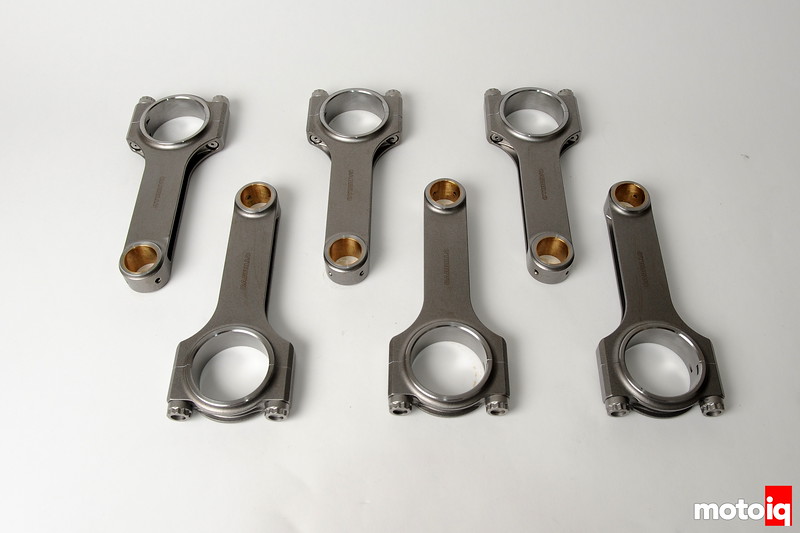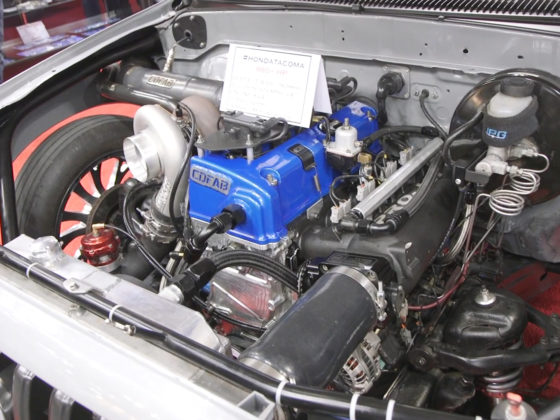
Our engine is now ready to get fully dressed so it can be installed. Now, this is not one of our super trick builds, just something basic and reliable for moderate power levels. For a VR with full bolt-ons, this can be in the 700 whp plus range!

So the next thing was to dress the engine for installation, adding the exhaust manifolds, turbos, downpipes, coolant lines, and front end accessories.

For a GT-R the easiest way to drop the motor is from the bottom, removing the entire front crossmember. So when reinstalling the motor we first bolt it back down onto the crossmember including the front suspension.

The entire assembly is then raised up back into the car or in this case, we lowered the car down onto it. This is actually a lot easier than it looks!

With the crossmember in place, the plumbing and wiring are reconnected and our engine is ready to go.
Unlike our other builds, this one will only possibly make slightly more power than stock due to our improved valve job and seat matching. The major difference is it will be bulletproof reliable at bolt-on power levels and will withstand up to 1000 hp of boost with bigger turbos if the owner desires later.
Sources
CP-Carrillo
King Bearings
Swain Tech Coatings




10 comments
i had always heard that Nissan engines, particularly the RBs, were underpowered in comparison to how robust they were. Those days, apparently, are long gone when we get 500+ HP out of bolt-on upgrades.
Any downsides to the narrow rod bearings?
Less surface area to maintain the oil film so less pressure needed before getting bearing wear. Good oil flow and pressure can somewhat mitigate it.
Very nice article, really accessible, will there be updates?
Also, I couldn’t help wonder, was there any discussion about the downpipes getting coated? Did any other goodies get thrown in “since you were in there anyway?”
Been a reader since SCC and still miss that magazine!
Other than the PC9 coating on the pistons, the parts were kept mostly stock. This was a customer car and they just wanted their car back. Though it may not seem like a lot was done, the total gets up there pretty quick thanks to the GT-R tax.
Great write up guys. Just to add some context:
The original motor was stock with about 90k mi on it, most of which was spent with the boost up for WOT on E85. It was not in fact bad gas that lead to failure but rather an accidental downshift at WOT which resulted in a low RPM load on the OEM rods. If that had not happened, my guess is the engine would still be alive. That tune had a reduction in torque as mentioned in the article. But even with the motor build, that mistake should not be repeated. if you have a GTR – don’t let that happen!
The owner just dynod the new setup and the results were impressive with the stock turbos. The head work appears to have netted a consistent gain in TQ across the rev range; but more impressively the peak TQ RMP was lowered by over 700 RPM’s down to 3,500 RPM’s.
Great build guys. Hi Howard, Mike and Martin.
I’ve really loved all of these modification articles / videos on the project GT-R. I was wondering if you would be making a video comparing the modified car’s performance to a stock car? Maybe quarter mile, 0-62, and a few laps on a track or Auto-X?
I think it would be really great to have some sort of benchmarking so that owners will know how the mods improve the car in more sure terms.
Thanks,
The car came here with a windowed block so no before!
could you be so kind to share you piston to wall clearance along with main and rod bearing clearance. this seems to be a very secretive issue when it comes to building a vr38 motor for about 1200hp or so.
We don’t give that information away either. Its part of our engine building service.